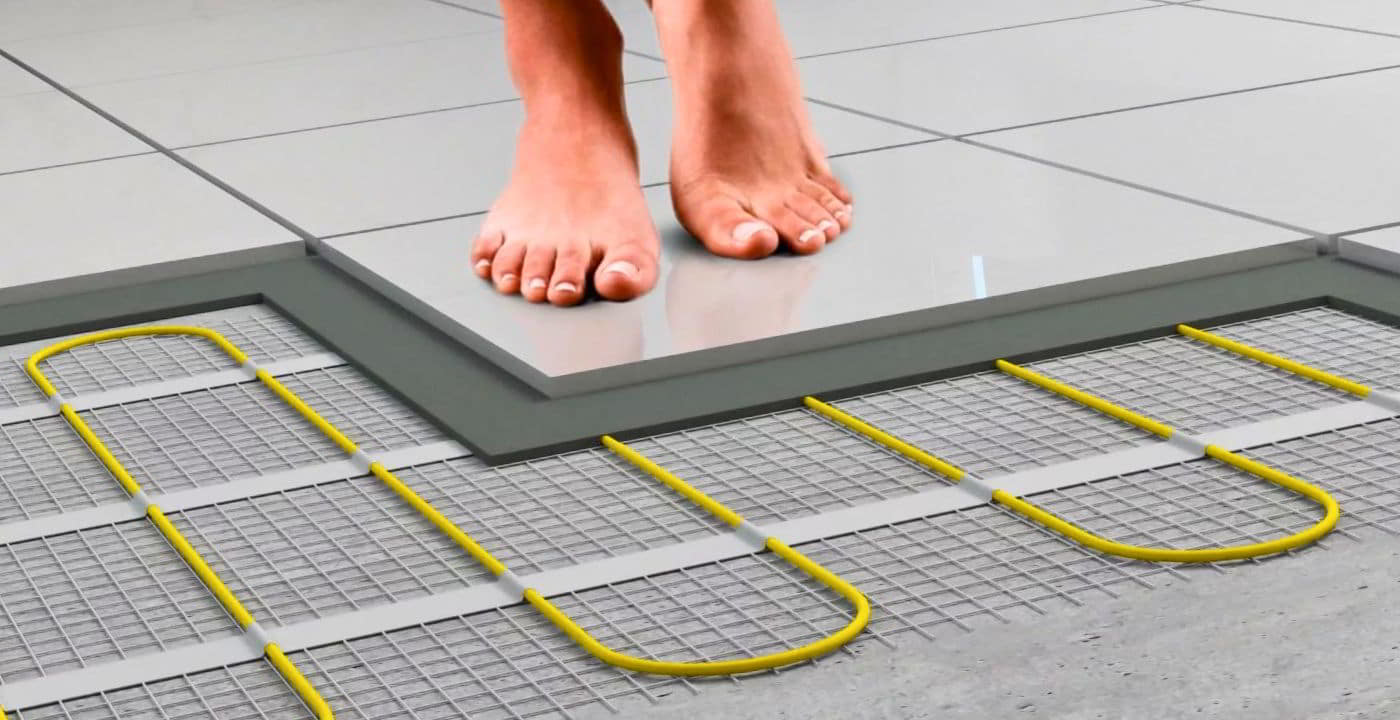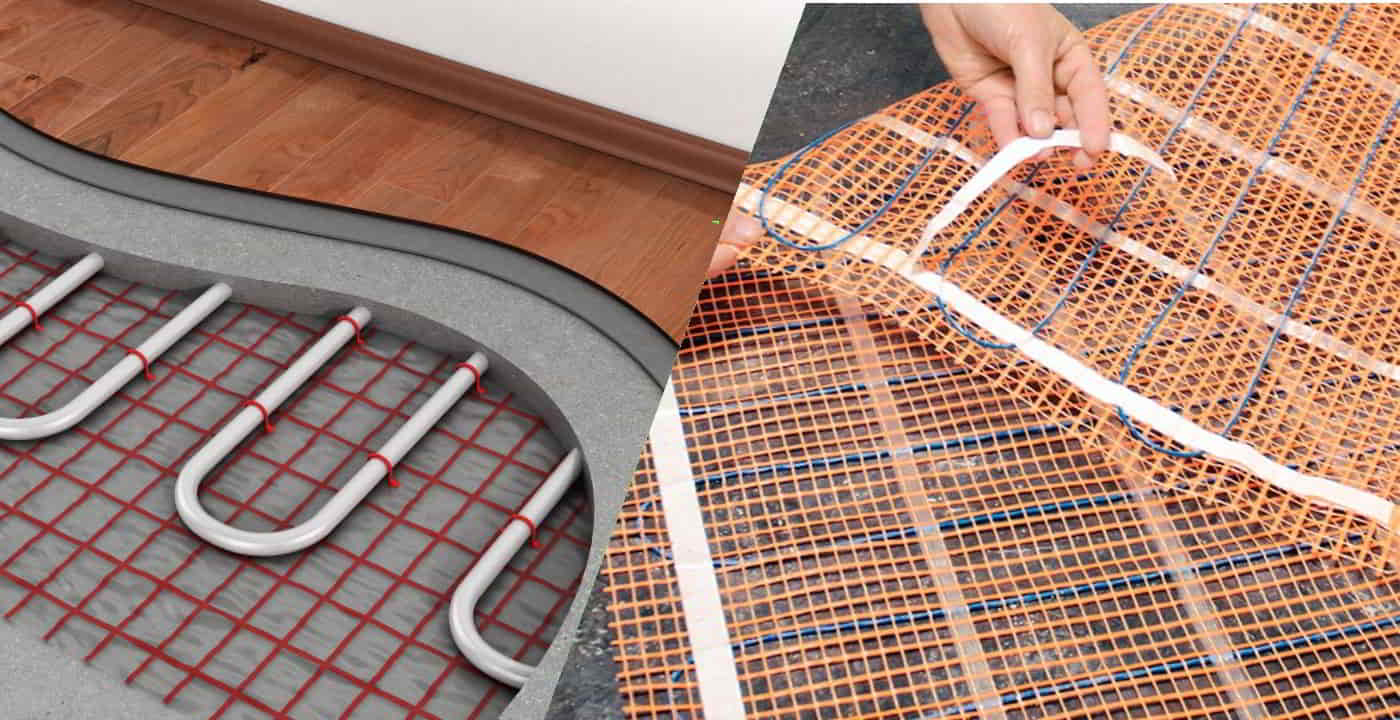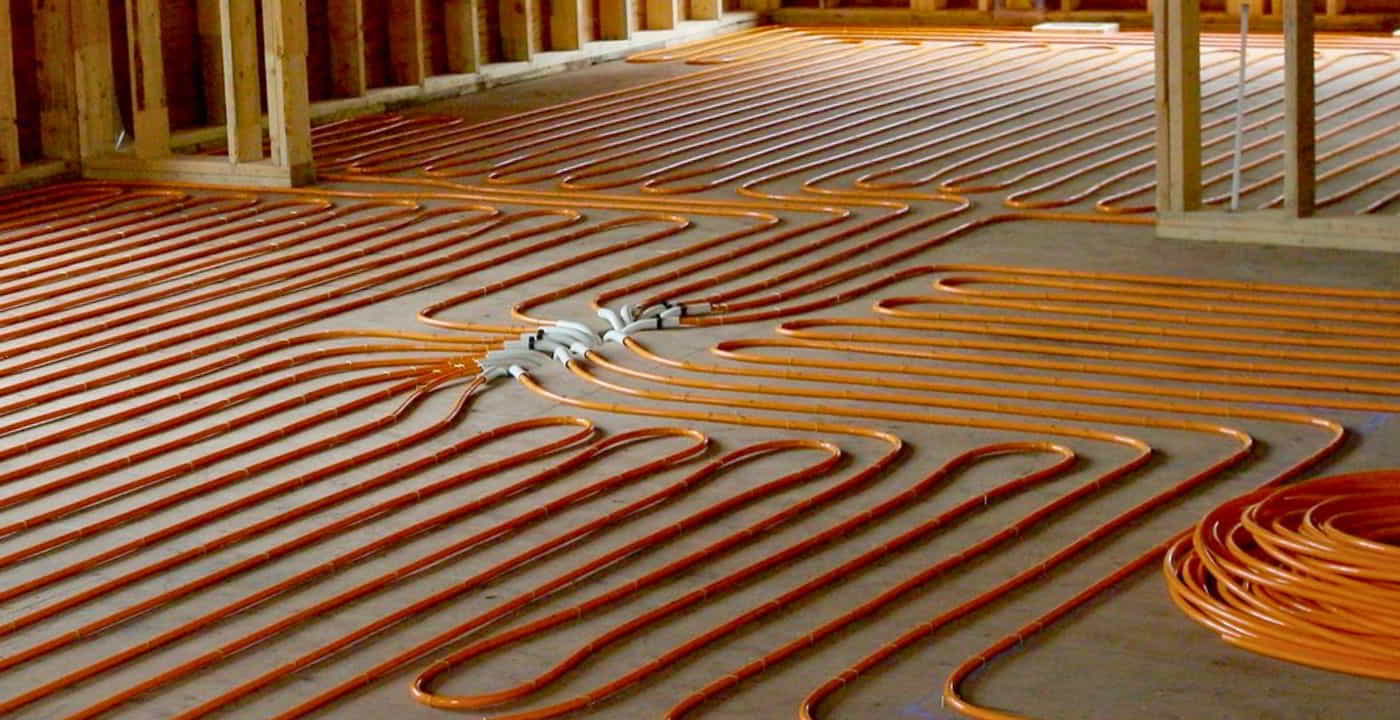Key Takeaways
- There are two main types of underfloor heating, hydronic and electric. Electric typically comes in the form of heat cables or electric heat mats.
- Electric underfloor heating typically has lower upfront costs. Running costs vary depending on the make and model, but traditionally hydronic is cheaper due to gas being cheaper to run than electricity.
The efficiency of your underfloor heating is significantly impacted by the insulation in your home. Always keep insulation front of mind when installing a new underfloor heating system.
Types Underfloor Heating Systems
1. Electric Underfloor Heating

Electric underfloor heating, often termed “dry” systems, utilizes thin wires or heating mats placed beneath the floor.
Once switched on, these wires heat up, warming the floor surface and radiating heat throughout the room.
The system is powered through the mains electricity and is typically controlled using a thermostat.
This system can be installed beneath various flooring types and is especially prevalent in modern builds.
However, retrofits in older properties are also feasible but may involve lifting the existing flooring.
Pros and Cons
Pros:
- Easy Installation: Especially suited for retrofitting in existing properties.
- Flexibility: Can be used for individual rooms without needing a comprehensive system overhaul.
- Compatibility: Works with various flooring types, from tiles to laminates.
- Space-saving: Eliminates the need for radiators, freeing up wall space.
Cons:
- Higher Running Costs: Electricity is generally less efficient than gas, leading to higher operational costs.
- Longer Warm-Up Time: Electric systems may take longer to heat up than their hydronic counterparts.
- Floor Height Concerns: Installation might slightly raise the floor level, which can impact door clearances.
- Less Efficient for Larger Areas: More suited for smaller spaces like bathrooms or kitchens
Estimated Cost
Electric underfloor heating systems generally have lower upfront costs than hydronic systems.
Depending on the size and specific needs of a room, installation can range between £500 to £8,000.
Electric Radiant Heating Systems: Wires vs. Mats

One of the main differentiators in electric underfloor heating systems is the form in which the electrical elements are deployed.
Broadly, this comes down to two types: loose-fit wiring systems and mat systems. Here’s an exploration of the distinctions between them and the advantages and disadvantages of each.
Loose-Fit Wire Systems
Loose-fit wire systems, as the name suggests, consist of standalone wires that are laid out across the floor.
They offer flexibility, making them ideal for irregularly shaped rooms where custom layouts are necessary.
Pros:
- Flexibility: Can be maneuvered around obstacles and adapted to fit any room shape.
- Custom Layouts: Perfect for irregular spaces or rooms with multiple fixtures, ensuring every part of the floor is heated.
- Consistent Heating: Due to their layout flexibility, they can provide more consistent heating in complex room shapes.
Cons:
- Installation Time: Can be time-consuming to install, especially in larger spaces, as each wire needs to be laid out manually.
- Potential for Errors: Greater chances of installation errors, like wires placed too close together, which can result in hotspots.
Electric Mat Systems
Mat systems are essentially wires that come pre-spaced on mesh mats.
These mats are rolled out across the floor, making installation quicker and more streamlined, especially in larger, more regularly shaped spaces.
Pros:
- Quick Installation: Easier and faster to install, especially for DIYers.
- Uniform Spacing: Pre-spaced wires ensure a consistent heat spread, reducing the chance of hotspots.
- Scalability: Great for larger spaces, as mats can simply be rolled next to each other, covering large areas quickly.
Cons:
- Less Flexible: Can be challenging to adapt to irregular room shapes or rooms with many fixtures.
- Size Limitations: Mats come in predetermined sizes, which may not perfectly fit every room, leading to potential wastage or underutilized spaces.
The choice between wire systems and mat systems often hinges on the specific needs of the room in question.
For complex spaces with irregularities, the loose-fit wire systems provide the adaptability necessary.
On the other hand, for larger, more standard spaces, the mat systems offer a quick and efficient installation process.
As with all home improvement decisions, it’s essential to consider the specific needs of your space and consult with a professional when in doubt.
2. Hydronic Underfloor Heating

Also known as ‘wet’ underfloor heating, hydronic systems circulate warm water through a series of polyethylene pipes beneath the floor.
This water is heated using a furnace or other heating sources, distributing warmth evenly across the floor surface.
Pros and Cons
Pros:
- Energy Efficiency: Typically uses 15-40% less energy compared to traditional radiators.
- Cost-Effective: Although the initial investment might be higher, long-term operational costs are lower.
- Versatility: Compatible with various heat sources, including boilers, heat pumps, and solar panels.
- Optimal for Larger Spaces: Suitable for comprehensive home heating.
Cons:
- Complex Installation: More intricate than electric systems, especially in older properties.
- Higher Initial Costs: More components and plumbing needs lead to steeper upfront costs.
- Floor Height Issues: Similar to electric systems, it may raise the floor level.
- Installation Time: Requires more time for installation and setting up.
Estimated Cost
Hydronic underfloor heating typically costs between £80–£150 per square meter.
A small bathroom, for instance, may cost between £400 to £750, with costs increasing based on room size and specific requirements.
Whilst this covers the basics, there is a lot more when it comes to electric vs. water radiant heating.
What is the Best Heat Source for Underfloor Heating?
The best heat source often depends on the property’s infrastructure and the homeowner’s preference.
However, warm water underfloor heating is compatible with any fuel heating system, including gas, LPG, solar heating panels, and heat pumps.
Using heat pumps is particularly efficient as it can be up to 40% more efficient than traditional boiler and radiator systems.
What is the Most Efficient Underfloor Heating Layout?
Efficiency hinges on the room size, insulation quality, and flooring type.
An optimal layout ensures that the system covers the most trafficked and used areas, avoiding unnecessary heating in low-traffic zones.
Proper insulation is crucial to prevent heat loss downwards, while the type of flooring used will determine heat conduction efficiency.
FAQs
Is Underfloor Heating Safe for all Floor Types?
Underfloor heating is compatible with a range of flooring types, including tiles, laminates, engineered wood, and even carpets.
However, the efficiency might vary, with concrete, stone and ceramic tiles offering the best heat conduction.
Can I Combine Underfloor Heating with Traditional Radiators?
Yes, underfloor heating can complement existing heating systems, allowing homeowners to use both as per seasonal requirements.
How Long Does Underfloor Heating Last?
When installed and maintained properly, underfloor heating systems can have a lifespan of many decades, perhaps up to 50 years or even longer, making them a long-term investment for homeowners.
How Does Underfloor Heating Affect Air Quality in Homes?
Underfloor heating can reduce the circulation of dust and airborne allergens compared to traditional forced-air systems.
The heat radiates from the ground, limiting the disturbance of particles on the floor.
Are there any Restrictions on Placing Furniture over Underfloor Heated Areas?
One of the benefits of underfloor heating is the freedom it provides in room design.
Without radiators on the walls, furniture can be placed anywhere.
However, it’s wise to avoid placing very heavy furniture on areas with underfloor heating as it might restrict heat flow.
Conclusion
As the demand for energy-efficient and comfortable home heating solutions grows, underfloor heating stands out as a viable choice for many homeowners.
Whether opting for electric or hydronic systems, underfloor heating offers a blend of comfort, efficiency, and aesthetic appeal.
As with any home improvement project, consider your property’s specific needs, budget, and long-term benefits before making a decision.
If you’ve decided it’s time to take your home heating into the 21st century with industry-leading, why not start designing your new system today?





